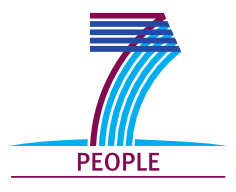Project duration:
February 1, 2011 – January 31, 2015
Overview
During its lifetime, the project has produced a number of substantial research highlights. The results have been published in 13 joint peer-reviewed publications, including one in Nature Commun., 6 further joint papers in preparation, and 34 joint conference contributions. In addition to that, 24 single team papers, two book chapters, one textbook, 54 single-team conference abstracts, and 37 invited talks are among the quantitative indicators of the scientific success of the project. The key scientific achievements of the project include the following highlights:
- the achievement of the highest to date photon storage efficiency;
- the proposal of novel techniques for manipulation of slow light and superluminal light;
- the demonstration of an all-optical switching scheme based on double slow light;
- the explanation of the dark state formation in hyperfine level systems and the proposal for accurate population manipulation in such systems;
- a complete description of transit-time broadening for Gaussian beams including novel compensation effects associated with the beam divergence;
- the proposal of a novel scheme for recoil- and Doppler-free three-photon excitation of Rydberg states
- the proposal of a novel technique for controlling the chaotic ionization regime in ultracold Rydberg gases;
- the proposal of a novel application of adiabatic passage technique for controlling the excitation of single Rydberg atoms;
- the demonstration of the broadening of Förster resonance lines by the photoions;
- the demonstration of the conversion of bright magneto-optical resonances into dark ones;
- the demonstration of nonlinear magneto-optical resonances in systems with large angular momentum and the proposal for their applications to ultra-sensitive magnetic field measurements;
- the demonstration of novel shape-changing effects in the level-crossing signals of the magneto-optical resonances.
- prediction of artificially “forbidden” transitions due to interference of multiple two-photon excitation pathways;
- demonstration of retrieval of dark state populations due to mixing of hyperfine states via Autler-Townes effect in the long interaction time limit of optical pumping experiments in experiments with cold atoms beams;
- utilization of ‘artificially’ forbidden transitions and destructive interference of multiple excitation paths for “engineering” of the selection rules in many-photon interactions;
- demonstration of a new cost-efficient method for realization of cost-efficient optical dipole traps;
- development of a novel stable computational scheme based on combination of Floquet method with Split Propagation Technique for investigation of a diffusion ionization of a Rydberg hydrogen atom in a microwave field;
- prediction and demonstration of the role of non-symmetrical Penning ionization of Rydberg atoms in evolution of a cold Rydberg gas into a cold plasma.
- description of a control scheme of superluminal light by multiple laser fields;
- demonstration of electromagnetically induced transparency and slow light in quantum degenerate atomic gases;
- development of a theoretical description of spinor slow light in a double-tripod system;
- application of the double tripod scheme as quantum memory/rotator for the two-color qubit, which paves the way for novel applications in quantum information manipulation, precision measurement and nonlinear optics (work published in Nature Commun. 5, 5542 (2014));
- demonstration of effects of coherent and incoherent processes on the shape of crossover resonances;
- realization of three-photon laser excitation of cold Rb Rydberg atoms in a switched MOT;
- development of novel schemes for realization of quantum logic gates with mesoscopic atomic qubits based on dipole blockade
- new experimental results on Förster resonance and dipole blockade in mesoscopic ensembles of cold Rb atoms;
- demonstration of a counterintuitive principal quantum number dependence in the Auger-type ionization of Rydberg gases
- observation of the radiofrequency assisted Förster resonances for a few cold interacting Rb Rydberg atoms, including “inaccessible” Förster resonances which cannot be tuned by dc electric field;
- prediction of the Jaynes-Cummings dynamics in mesoscopic ensembles of Rydberg-blockaded atoms with random number of atoms;
- theoretical study of saturated-absorption spectra and Hanle resonances for various mutual polarizations of the pump and probe light waves;
- demonstration of new coherent and incoherent magneto-optical effects along with theoretical models for their description;
- Development of a theoretical model to describe magneto-optical resonances in extremely thin cells taking into account atom collisions with walls and intensity distribution in the laser beam;
- Development of a prototype magnetic field measurement device based on extremely thin cells that allows for gradient resolution down to 2 mG/nm.
Transfer of Knowledge and Training activities
The main instrument of transfer of knowledge in this project is secondments, during which scientists from partner teams engage hands-on collaboration. Similarly as in the first half of the project, also the second half yielded new joint journal papers and joint contributions at international conferences.
Although organization of workshops has not been initially foreseen in this project, the tradition of joint international workshops was begun during the previous reporting period with a meeting in Riga in summer of 2012, and it was continued during the final two years of the project by organizing the second such workshop in Vilnius in September 2013 and the third one in 2014 in Hsinchu. Representatives from all five partner teams participated in the workshop, and a book of abstracts has been published.
Public Outreach activities
The project’s participants have also been engaged in public outreach activities, such as interviews and articles in magazines and scientist career promotion at schools.
Future activities
The project participants are currently drawing plans for continuing the collaboration, and a new RISE proposal to Horizon 2020 from an extended consortium is likely to materialize.
Project supported by European Commission Research & Innovation Seventh Framework Programme Marie Curie Actions – People

